Helping your child with their emotions can be difficult during normal circumstances, but in light of the current pandemic things may be even more complex. The constant unknown of the Coronavirus pandemic means for us all, we are in a heightened state of alert, leading to increased anxiety. The good news is, helping your child to regulate emotionally can be done at home.
Anxiety and fear impact on behaviour, particularly in children. Activities to support your children with regulating their emotions, provided the time is right, can be of great benefit to them. In the moment it can be hard for a child to reason and so it is important to remember that activities to regulate emotions are more of a long game than an immediate fix.
Here we explain the importance of helping your child with their emotions and provide specific activities you can do with your children at home with downloads available through our mailing list.
What is the importance of emotionally supporting my child?
Emotional regulation is the foundation of our relationships, learning and development. If we are emotionally dysregulated we struggle to relate to others, retain information, carry out basic tasks and learning new skills is hindered. Right now, for our children, emotional regulation is key. A lot of parents have attempted to ‘home school’ their children with really positive intentions; however, amidst a crisis such as this, without strong enough emotional foundations, home schooling is likely to be a difficult task. Children will present with decreased attention, more defiance, and learning will take much longer if at all.
Fundamentally, supporting your child with their emotions, will support their learning in the longer term. Not only will it support their time in social isolation and ‘lockdown’, but it will also support their transition back to ‘normal life’ when this happens. Our children need emotional support to ensure they can learn to the best of their ability when we press the reset button.
Signs my child is struggling to manage their emotions?
Perceived fear impacts on our brain activity and can lead to behaviours that are out of character. Some behaviours may be more obvious than others eg. shouting, crying, hitting etc. with other behaviours such as hyperactivity being less obvious. With all behaviours, it is important to remember, the behaviours you are seeing is not necessarily the emotions your child is experiencing. It may be that your child is showing you anger but this could be coming from a place of anxiety or fear.
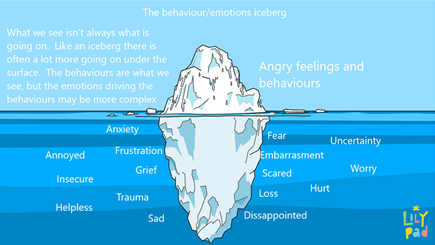
The uncertainty we are all experiencing means we are all naturally carrying increased levels of stress hormones. This means that all of our emotions are heightened. It may be that we cry more readily at Britain’s Got Talent or we feel aggrieved more quickly by something that would not usually both us. The same goes for our children. Anxiety is likely to be an emotion felt by many at the moment, but the expression of this emotion is complex and difficult to convey without the use of words and putting emotions into words is a complex task for children.
What activities can I do with my child?
So how is it you can help your child? What activities can you do with them?
When your child is emotionally dysregulated, in the moment, activities are best avoided. Help them find an appropriate outlet for the energy they are holding. Bubbles can be a really helpful tool in regulating a child’s emotions. They can ‘blow’ their feelings into the bubbles, or you can blow and they can pop them. Bubbles can bring a sense of calm to a situation. One of our recent posts offers strategies to support in the moment – Coronavirus & Emotions
Feelings Chart – For a feelings chart draw different faces expressing different emotions. Include positive emotions too. It may be that you draw this or for those able to (over age 6) get them to choose emojis to express their different emotions. You could get the craft box out and make the faces on paper plates or somewhere in between depending where your tolerance for creative tasks lies! Using an indicator with blue tac, you can then later use this to help them express themselves if they are having a tough time.
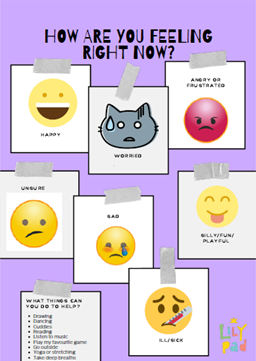
Feelings in my body – To help children explore feelings, thinking about the different parts of the body, how they feel or what those body parts do when your child feels a certain emotion can be really helpful. Thinking about when they are worried how their tummy feels or when they think about things that are happening in the world how their head feels for example. Drawing this in some way (however they want to) on the outline of a person can be a useful tool to communicate to you how they are feeling allowing you a better understanding of their emotions and also to allow them to identify their emotional feelings from their physical feelings.
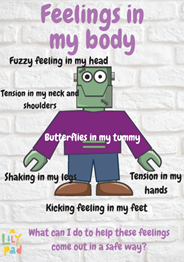
Explore the senses – If you are sensing your child may be struggling to regulate, you might want to invite your child to play outside or try to involve them in sensory play such as play with sand. Sand has a very calming effect for children who are feeling emotionally dysregulated. Painting or simply drawing alongside your child can be really powerful in allowing them to feel a connection with you and you to them. When doing these tasks try to resist asking ‘what is it’, and allow it to be, drawings don’t have to be of ‘things’ they can simply be a collection of marks on a page and this is okay. Embrace the silence and resist the urge to fill it.
Thermometer – For this task, draw a thermometer with your child or use a template. Chose a measure at the side; a measure that fits for them. This could be 0-5 or cold to hot for example. Using blue tac you can add an arrow. Your child can then use this to express to you how they are feeling at any given time, or you can use it to indicate to them that you feel their mood is changing so they can chose an activity to calm.
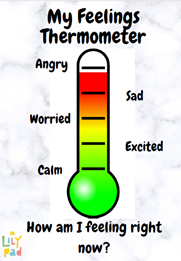
Worry Box – using any box, create with your child a worry box. This can be any size and your child can then write on a piece of paper their worries, thoughts and feelings. You can then use this to talk with them about how it is they are feeling, things that may be on their mind. Depending on the age of your child, they may want to colour code their worries. There may be things they do not feel ready to talk about, but want you to know and so this could be on a certain coloured paper, and worries they want to discuss on a different colour.
Stress/feelings bucket – For older children, this one can be more effective. Draw a bucket or download one if you aren’t feeling arty! Get them to write the things that are causing them negative emotions either in the bucket or in drips going into it. The idea of this is to think of each ‘stress’ as another drip of water into the bucket. These things add up and the bucket will eventually overflow. The way in which this can be avoided is for water to be taken out. The way to take water out is to think about the positive activities your child can do to relieve their stresses – it might be listening to music, drawing, yoga or talking to a friend, for example.
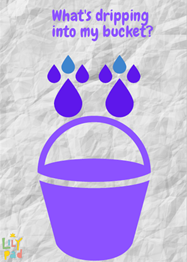
Yoga, stretching, dancing – Moving! Movement is a great way to get feelings out, increase oxytocin (happy hormones!) and have fun! There are kids yoga videos on YouTube (check out Cosmic Kids Yoga), play music and just dance with your children. It is a great way to connect.
Books – There are a lot of good books out there talking about emotions. In light of the current lockdown, The Invisible String by Patrice Karst is a lovely book describing how we are all connected by an invisible string of love. There are also more general books like ‘The Great Big book of Feelings’ by Mary Hoffman to support you in talking with your child about emotions. The Inner Chimp is a workbook with activities you can do directly with your children which explore emotions too.
There are a lot of resources you can access, and we will be sending out further activities and blank versions of these to those who have registered on our mailing list; contact us if you too would like these. You do not have to do something structured. Simply sitting alongside your child in their play, colouring with them or dancing with them can be really effective in helping your child feel connected to you and in turn regulating their emotions.

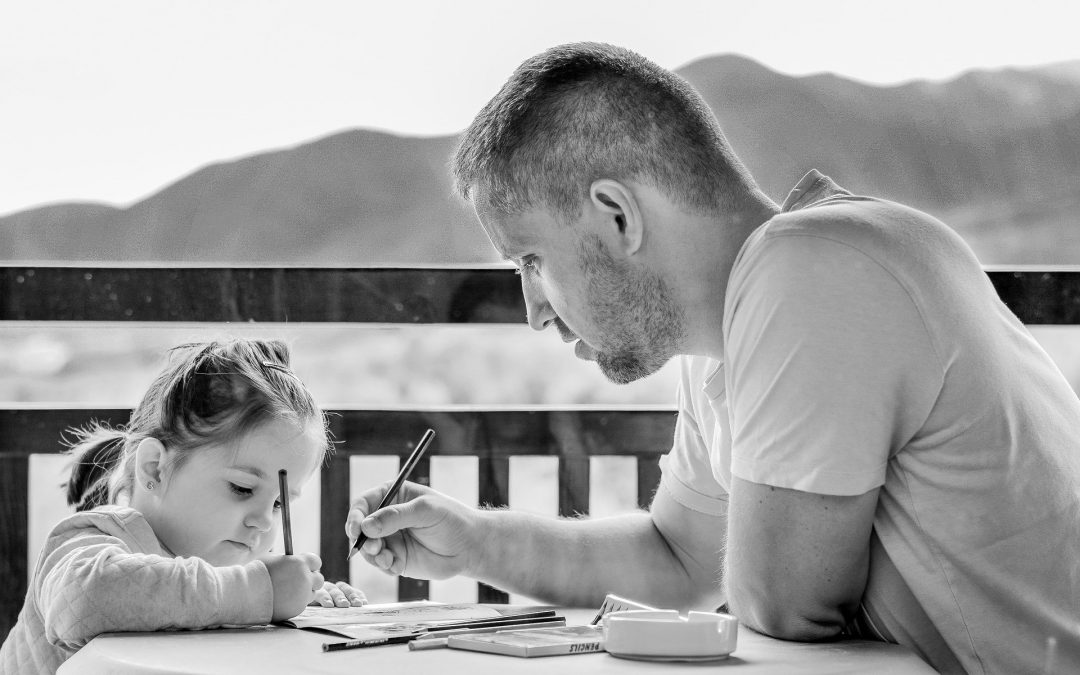
Recent Comments